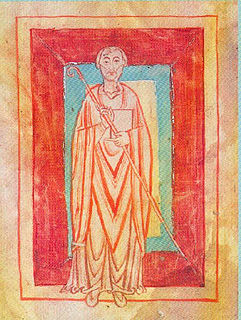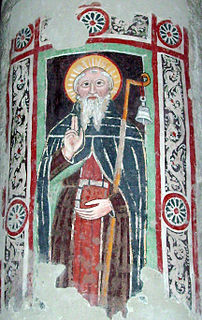
Saint Wolfgang of Regensburg was bishop of Regensburg in Bavaria from Christmas 972 until his death. He is a saint of the Catholic and Eastern Orthodox churches. He is regarded as one of the three great German saints of the 10th century, the other two being Saint Ulrich of Augsburg and Saint Conrad of Constance. Towards the end of his life Wolfgang withdrew as a hermit to a solitary spot, in the Salzkammergut region of Upper Austria. Soon after Wolfgang's death many churches chose him as their patron saint, and various towns were named after him.

The Blessed Gamelbert was a Christian priest, who worked in the 8th century in the area of the present Deggendorf in Bavaria in Germany.

William of Hirsau was a Benedictine abbot and monastic reformer. He was abbot of Hirsau Abbey, for whom he created the Constitutiones Hirsaugienses, based on the uses of Cluny, and was the father of the Hirsau Reforms, which influenced many Benedictine monasteries in Germany. He supported the papacy in the Investiture Controversy. In the Roman Catholic Church, he is a Blessed, the second of three steps toward recognition as a saint.

Saint Emmeram's Abbey, now known as Schloss Thurn und Taxis, Schloss St. Emmeram or St. Emmeram's Basilica, was a Benedictine monastery founded in about 739 at Regensburg in Bavaria at the grave of the itinerant Frankish bishop Saint Emmeram.

Saint Ulrich of Zell, also known as Wulderic, sometimes of Cluny or of Regensburg, was a Cluniac reformer of Germany, abbot, founder and saint.

The Hiberno-Scottish mission was a series of missions and expeditions initiated by various Irish clerics and cleric-scholars who, for the most part, are not known to have acted in concert.

Prüfening Abbey was a Benedictine monastery on the outskirts of Regensburg in Bavaria, Germany. Since the beginning of the 19th century it has also been known as Prüfening Castle. Notably, its extant dedicatory inscription, commemorating the founding of the abbey in 1119, was created by printing and is a unique document of medieval typography.

Mondsee Abbey was a Benedictine monastery in Mondsee in Upper Austria.

Saint Emmeram of Regensburg was a Christian bishop and a martyr born in Poitiers, Aquitaine. Having heard of idolatry in Bavaria, Emmeram travelled to Ratisbon (Regensburg) some time after the year 649 to the court of Theodo I, Duke of Bavaria. He supposedly travelled up the Loire, crossed through the Black Forest and then followed the Danube to Regensburg. Theodo welcomed Emmeram to his court, where he laboured for three years carrying out missionary work. During this time, he gained a reputation as a pious man. He died circa 652 and is buried in St. Emmeram's in Regensburg, Germany. His feast day in the Catholic Calendar of saints is September 22.
Gebhard I, known as Gebhard of Swabia, was the Bishop of Regensburg from 994 until his death.

Gorze Abbey was a Benedictine monastery in Gorze in the present arrondissement of Metz, near Metz in Lorraine. It was prominent as the source of a monastic reform movement in the 930s.

Hillin of Falmagne, was the Archbishop of Trier from 1152. He was an imperialist and a partisan of Frederick Barbarossa in the Investiture Controversy of the twelfth century.

Saint Germanus of Granfelden (* ca. 612 in Trier; † 675 near Moutier was the first abbot of Moutier-Grandval Abbey.
The Obermünster, or Obermünster Abbey, Regensburg, was a collegiate house of canonesses (Frauenstift) in Regensburg, Bavaria, second only to Niedermünster in wealth and power.

Father Emmeram of Thurn and Taxis OSB, until his profession Prince Max Emanuel Maria Siegfried Joseph Antonius Ignatius Lamoral of Thurn and Taxis was a German Benedictine and member of the Princely House of Thurn and Taxis.
Gaubald was the first bishop of Regensburg after the foundation of the diocese of Regensburg. He has been beatified. His name is also spelled Gawibald, Geupald or Gaibald.
Saint Sturm, also called Sturmius or Sturmi, was a disciple of Saint Boniface and founder and first abbot of the Benedictine monastery and abbey of Fulda in 742 or 744. Sturm's tenure as abbot lasted from 747 until 779.
Saint Burchard of Meissen was the first Bishop of Meissen, from 968.
Egbert was abbot of Fulda Abbey, a Benedictine abbey in Fulda, Germany.

Lubentius is a Christian saint, venerated by the Catholic Church. A patron saint of the boatmen on the River Lahn, his feast day is 13 October.














